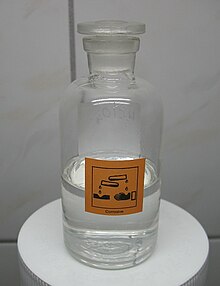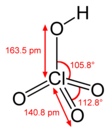Hclo4 Weak Or Strong Acid
| |||
 | |||
| Names | |||
|---|---|---|---|
| Systematic IUPAC name chloric(VII) acid | |||
| Other names Hyperchloric acid[1] | |||
| Identifiers | |||
| CAS Number |
| ||
| 3D model (JSmol) |
| ||
| ChEBI |
| ||
| ChEMBL |
| ||
| ChemSpider |
| ||
| ECHA InfoCard | 100.028.648 | ||
| EC Number |
| ||
| PubChem CID |
| ||
| RTECS number |
| ||
| UNII |
| ||
| United nations number | 1873 | ||
| CompTox Dashboard (EPA) |
| ||
| InChI
| |||
| SMILES
| |||
| Properties | |||
| Chemical formula | HClOiv | ||
| Molar mass | 100.46 k/mol | ||
| Appearance | colorless liquid | ||
| Odour | odorless | ||
| Density | 1.768 g/cm3 | ||
| Melting bespeak | −17 °C (1 °F; 256 K) (72% aqueous solution)[2] −112 °C (anhydrous) | ||
| Boiling point | 203 °C (397 °F; 476 Yard) (azeotrope)[2] | ||
| Solubility in water | Miscible | ||
| Acidity (pOne thousand a) | −xv.two (±ii.0);[3] ≈ −x | ||
| Conjugate base | Perchlorate | ||
| Hazards | |||
| Occupational prophylactic and health (OHS/OSH): | |||
| Main hazards | Powerful oxidizer, highly corrosive | ||
| GHS labelling: | |||
| Pictograms |     | ||
| Indicate word | Danger | ||
| Hazard statements | H271, H290, H302, H314, H373 | ||
| Precautionary statements | P210, P280, P303+P361+P353, P304+P340, P305+P351+P338, P310, P371, P375, P380 | ||
| NFPA 704 (burn diamond) | 3 0 3 OX | ||
| Flash betoken | Non-flammable | ||
| Safety data sail (SDS) | ICSC 1006 | ||
| Related compounds | |||
| Related compounds | Hydrochloric acrid Hypochlorous acrid Chlorous acid Chloric acid | ||
| Except where otherwise noted, data are given for materials in their standard state (at 25 °C [77 °F], 100 kPa). Infobox references | |||
Perchloric acrid is a mineral acid with the formula HClO4. Usually institute as an aqueous solution, this colorless compound is a stronger acrid than sulfuric acid, nitric acid and hydrochloric acrid. It is a powerful oxidizer when hot, just aqueous solutions upwards to approximately 70% past weight at room temperature are generally condom, but showing stiff acid features and no oxidizing properties. Perchloric acid is useful for preparing perchlorate salts, especially ammonium perchlorate, an important rocket fuel component. Perchloric acrid is dangerously corrosive and readily forms potentially explosive mixtures.
History [edit]
Perchloric acid was first synthesized (together with potassium perchlorate) by Austrian chemist Friedrich von Stadion and called "oxygenated chloric acid" in mid-1810s; French pharmacist Georges-Simon Serullas introduced the modern designation along with discovering its solid monohydrate (which he, however, mistook for an anhydride).[iv]
| | This department needs expansion. You can aid by adding to it. (July 2022) |
Production [edit]
Perchloric acid is produced industrially by 2 routes. The traditional method exploits the loftier aqueous solubility of sodium perchlorate (209 g/100 mL of water at room temperature). Treatment of such solutions with hydrochloric acid gives perchloric acid, precipitating solid sodium chloride:
- NaClO4 + HCl → NaCl + HClOiv
The full-bodied acrid can exist purified by distillation. The alternative road, which is more direct and avoids salts, entails anodic oxidation of aqueous chlorine at a platinum electrode.[5] [6]
Laboratory preparations [edit]
Treatment of barium perchlorate with sulfuric acid precipitates barium sulfate, leaving perchloric acrid. It tin also exist fabricated by mixing nitric acid with ammonium perchlorate and boiling while calculation hydrochloric acid. The reaction gives nitrous oxide and perchloric acid due to a concurrent reaction involving the ammonium ion and can exist concentrated and purified significantly by boiling off the remaining nitric and hydrochloric acids.
Backdrop [edit]
Anhydrous perchloric acid is an unstable oily liquid at room temperature. Information technology forms at to the lowest degree five hydrates, several of which have been characterized crystallographically. These solids consist of the perchlorate anion linked via hydrogen bonds to H2O and HiiiO+ centers.[7] Perchloric acid forms an azeotrope with water, consisting of about 72.5% perchloric acid. This course of the acid is stable indefinitely and is commercially available. Such solutions are hygroscopic. Thus, if left open up to the air, concentrated perchloric acid dilutes itself past absorbing water from the air.
Dehydration of perchloric acid gives the anhydride dichlorine heptoxide:[8]
- ii HClO4 + P4Ox → Cl2O7 + HtwoP4Oxi
Uses [edit]
Perchloric acid is mainly produced as a forerunner to ammonium perchlorate, which is used in rocket fuel. The growth in rocketry has led to increased production of perchloric acid. Several million kilograms are produced annually.[5] Perchloric acid is ane of the nigh proven materials for etching of liquid crystal displays and disquisitional electronics applications every bit well as ore extraction and has unique properties in analytical chemistry.[9] Additionally it is a useful component in etching of chrome.[ten]
Every bit an acrid [edit]
Perchloric acrid, a superacid, is one of the strongest Brønsted–Lowry acids. That its pK a is lower than −9 is evidenced past the fact that its monohydrate contains discrete hydronium ions and tin can be isolated as a stable, crystalline solid, formulated every bit [H3O+][ClO –
4 ].[eleven] The most recent approximate of its aqueous pK a is −15.two±2.0.[three] Information technology provides strong acidity with minimal interference because perchlorate is weakly nucleophilic (explaining the high acidity of HClO4). Other acids of noncoordinating anions, such every bit fluoroboric acid and hexafluorophosphoric acid are susceptible to hydrolysis, whereas perchloric acid is not. Despite hazards associated with the explosiveness of its salts, the acrid is often preferred in sure syntheses.[12] For similar reasons, it is a useful eluent in ion-exchange chromatography.
It is as well used for electropolishing or etching of aluminium, molybdenum, and other metals.
Safety [edit]
Given its strong oxidizing properties, perchloric acid is subject to extensive regulations as it can react violently with metals and flammable substances such as wood, plastics, and oils.[13] Work conducted with perchloric acid must exist conducted in fume hoods with a wash-down adequacy to forbid accumulation of oxidisers in the ductwork.
On Feb 20, 1947 in Los Angeles, California, 17 people were killed and 150 injured in the O'Connor Plating Works disaster. A bath, consisting of over chiliad litres of 75% perchloric acid and 25% acerb anhydride past volume which was beingness used to electro-shine aluminium furniture, exploded. Organic compounds were added to the overheating bath when an iron rack was replaced with one coated with cellulose acetobutyrate (Tenit-2 plastic). A few minutes after the bath exploded.[14] [15] The O'Connor Electro-Plating plant, 25 other buildings, and twoscore automobiles were destroyed, and 250 nearby homes were damaged.
Run into also [edit]
- Chloric acid
- Oxidizing acid
References [edit]
- ^ Fomon, S. (1920). Medicine and the Centrolineal Sciences. Medicine and the Centrolineal Sciences. D. Appleton. p. 148.
- ^ a b "Safety (MSDS) data for perchloric acrid, 70%". msds.chem.ox.ac.uk. 2 July 2008. Archived from the original on 2 July 2008. Retrieved 24 February 2022.
- ^ a b Trummal, Aleksander; Lipping, Lauri; Kaljurand, Ivari; Koppel, Ilmar A.; Leito, Ivo (6 May 2016). "Acerbity of Strong Acids in Water and Dimethyl Sulfoxide". The Journal of Physical Chemistry A. American Chemical Order (ACS). 120 (20): 3663–3669. Bibcode:2016JPCA..120.3663T. doi:10.1021/acs.jpca.6b02253. ISSN 1089-5639. PMID 27115918. S2CID 29697201.
- ^ http://www.sciencemadness.org/library/books/perchloric_acid_and_perchlorates.pdf[ bare URL PDF ]
- ^ a b Helmut Vogt, Jan Balej, John E. Bennett, Peter Wintzer, Saeed Akbar Sheikh, Patrizio Gallone "Chlorine Oxides and Chlorine Oxygen Acids" in Ullmann's Encyclopedia of Industrial Chemistry 2002, Wiley-VCH, Weinheim. doi:10.1002/14356007.a06_483.
- ^ Müler, W.; Jönck, P. (1963). "Herstellung von Perchlorsäure durch anodische Oxydation von Chlor". Chemie Ingenieur Technik. 35 (2): 78. doi:10.1002/cite.330350203. ; German patent DE1031288B; US patent US2846383A.
- ^ Almlöf, J.; Lundgren, J. O.; Olovsson, I. (15 May 1971). "Hydrogen bond studies. XLV. The crystal structure of HClO4.two.5H2O". Acta Crystallographica Department B: Structural Crystallography and Crystal Chemistry. International Union of Crystallography (IUCr). 27 (5): 898–904. doi:10.1107/s0567740871003236. ISSN 0567-7408.
- ^ Holleman, Arnold F.; Wiberg, Egon (2001). Inorganic chemical science. Translated by Mary Eagleson, William Brewer. San Diego: Academic Press. p. 464. ISBN0-12-352651-5.
- ^ "Perchloric Acrid". GFS chemicals. Archived from the original on 2015-01-31. Retrieved 2014-01-14 .
- ^ "Metallic Etching". Thayer School of Engineering.
- ^ Kathleen Sellers; Katherine Weeks; William R. Alsop; Stephen R. Clough; Marilyn Hoyt; Barbara Pugh (2006). Perchlorate: ecology problems and solutions. CRC Press. p. sixteen. ISBN0-8493-8081-two.
- ^ A. T. Balaban, C. D. Nenitzescu, K. Hafner and H. Kaiser (1973). "2,4,6-Trimethylpyrilium Perchlorate". Organic Syntheses.
{{cite journal}}: CS1 maint: multiple names: authors list (link); Commonage Book, vol. 5, p. 1106 - ^ "Materials Prophylactic Data Sail - Perchloric Acid, 60%, GR" (PDF). emd chemicals. 2003. Archived from the original (PDF) on 24 March 2012. Retrieved 24 February 2022.
- ^ R. C. Nester; G. F. Vander Voort (1992). Safety in the Metallographic Laboratory. ASTM Standardization News. p. 34.
- ^ "CALIFORNIA: The Amazing Brew". Fourth dimension.com. March 3, 1947.
External links [edit]
- International Chemical Prophylactic Menu 1006
- v
- t
- e
Hclo4 Weak Or Strong Acid,
Source: https://en.wikipedia.org/wiki/Perchloric_acid
Posted by: thorntontheinglee.blogspot.com





0 Response to "Hclo4 Weak Or Strong Acid"
Post a Comment